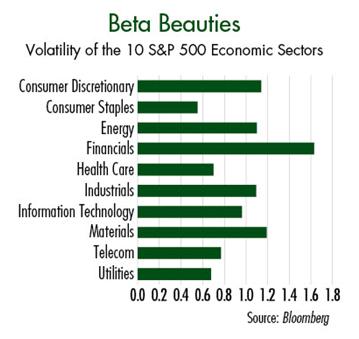Traditional thoughts holds that blue chip names such as food and beverage manufacturers are slow-growth stocks that hold up best when the markets are troubled and underperform when equities perk up.
But that’s a misconception. As “Defensive Stocks Play Offense” shows, the S&P 500 Consumer Staples Index has soared nearly 130 percent since 2000—compared to the 17 percent gain posted by the S&P 500—and outperformed its parent index in all but the strongest bull markets. These outsized returns were produced with significantly less volatility (see “Beta Beauties”).

Consumer staples and healthcare, two of the most defensive groups in the S&P 500, are among my favorite sectors. They’re a great way to enjoy strong growth and low volatility.
With information technology and other market-leading sectors increasingly vulnerable to a pullback, investors should take profits on high-flyers and reallocate the proceeds to defensive names that are poised to take off.
Here’s a look at one stock that fits the bill:
The largest food manufacturer in the US, Kraft Foods (NYSE: KFT) is behind some of the world’s most iconic brands, including Oreo cookies, Trident gum, Planters nuts, Philadelphia Cream Cheese and, thanks to a USD19.4 billion acquisition in 2010, UK-based Cadbury chocolates.
As with Sara Lee Corp (NYSE: SLE), profiled here, the investment case for Kraft Foods rests on its imminent split into two companies: a slow-growing, North American grocery business that pays an ample dividend and a rapidly growing international snack food company. Kraft plans to separate its financial statements in the second quarter of 2012 and will finalize the split before the end of the year.
In North America, packaged-foods manufacturers have suffered from weak volume growth because of a sluggish economy and consumers’ preference for value brands. Kraft Foods’ unit sales were off 0.6 percent in 2011, but this disappointment wasn’t as bad as the 2.4 percent decline for the US food and beverage industry as a whole.
The good news: Kraft Foods has generated growth in a weak economy by boosting prices, cutting costs, introducing new products and eliminating underperforming products. Although sales volumes were off overall, net revenues for its “power brands” were up 4.5 percent, aided by a significant boost in marketing.
New product introductions in 2011 were mainly extensions of existing brands such as a line of chocolate Philadelphia spreads, new “healthy lifestyle” meat products under the Oscar Mayer line and a spicy Ritz cheese cracker. Higher-margin new products accounted for about 9 percent of net revenue in 2011, up from 6.5 percent two years ago.
The North American grocery business isn’t likely to be a fast grower, but can continue to generate solid cash flows and reliable profit margins. The company plans to institute a substantial dividend payout for this business, with a likely yield of 4 percent or higher.
Meanwhile, Kraft’s international snack foods business is the growth play, generating 44 percent of its $35 billion in total revenue from developing markets. The company’s biscuit brands portfolio—including Oreo, LU and belVita—saw net organic revenue growth of 9 percent in 2011, with developing markets up at a double-digit pace and developed markets posting respectable growth in the mid-single digits. In Russia and China, biscuit sales were up roughly 40 percent in 2011.
In chocolates, total sales were up 6 percent but developing market sales were up well into the double digits. In India, for example, the company has generated strong growth in this category by distributing refrigerated displays known as Visi Coolers to all parts of the country. These chilled displays maintain chocolates at their ideal temperature even in the hot Indian climate.
The planned Kraft split will heighten the value of the firm’s brands and its growth potential in emerging markets.
- English (UK)
- English (India)
- English (Canada)
- English (Australia)
- English (South Africa)
- English (Philippines)
- English (Nigeria)
- Deutsch
- Español (España)
- Español (México)
- Français
- Italiano
- Nederlands
- Português (Portugal)
- Polski
- Português (Brasil)
- Русский
- Türkçe
- العربية
- Ελληνικά
- Svenska
- Suomi
- עברית
- 日本語
- 한국어
- 简体中文
- 繁體中文
- Bahasa Indonesia
- Bahasa Melayu
- ไทย
- Tiếng Việt
- हिंदी
Kraft Foods: A Good Play For Reducing Portfolio Volatility In Today’s Markets
Published 03/26/2012, 10:32 AM
Updated 07/09/2023, 06:31 AM
Kraft Foods: A Good Play For Reducing Portfolio Volatility In Today’s Markets
Latest comments
Loading next article…
Install Our App
Risk Disclosure: Trading in financial instruments and/or cryptocurrencies involves high risks including the risk of losing some, or all, of your investment amount, and may not be suitable for all investors. Prices of cryptocurrencies are extremely volatile and may be affected by external factors such as financial, regulatory or political events. Trading on margin increases the financial risks.
Before deciding to trade in financial instrument or cryptocurrencies you should be fully informed of the risks and costs associated with trading the financial markets, carefully consider your investment objectives, level of experience, and risk appetite, and seek professional advice where needed.
Fusion Media would like to remind you that the data contained in this website is not necessarily real-time nor accurate. The data and prices on the website are not necessarily provided by any market or exchange, but may be provided by market makers, and so prices may not be accurate and may differ from the actual price at any given market, meaning prices are indicative and not appropriate for trading purposes. Fusion Media and any provider of the data contained in this website will not accept liability for any loss or damage as a result of your trading, or your reliance on the information contained within this website.
It is prohibited to use, store, reproduce, display, modify, transmit or distribute the data contained in this website without the explicit prior written permission of Fusion Media and/or the data provider. All intellectual property rights are reserved by the providers and/or the exchange providing the data contained in this website.
Fusion Media may be compensated by the advertisers that appear on the website, based on your interaction with the advertisements or advertisers.
Before deciding to trade in financial instrument or cryptocurrencies you should be fully informed of the risks and costs associated with trading the financial markets, carefully consider your investment objectives, level of experience, and risk appetite, and seek professional advice where needed.
Fusion Media would like to remind you that the data contained in this website is not necessarily real-time nor accurate. The data and prices on the website are not necessarily provided by any market or exchange, but may be provided by market makers, and so prices may not be accurate and may differ from the actual price at any given market, meaning prices are indicative and not appropriate for trading purposes. Fusion Media and any provider of the data contained in this website will not accept liability for any loss or damage as a result of your trading, or your reliance on the information contained within this website.
It is prohibited to use, store, reproduce, display, modify, transmit or distribute the data contained in this website without the explicit prior written permission of Fusion Media and/or the data provider. All intellectual property rights are reserved by the providers and/or the exchange providing the data contained in this website.
Fusion Media may be compensated by the advertisers that appear on the website, based on your interaction with the advertisements or advertisers.
© 2007-2024 - Fusion Media Limited. All Rights Reserved.
